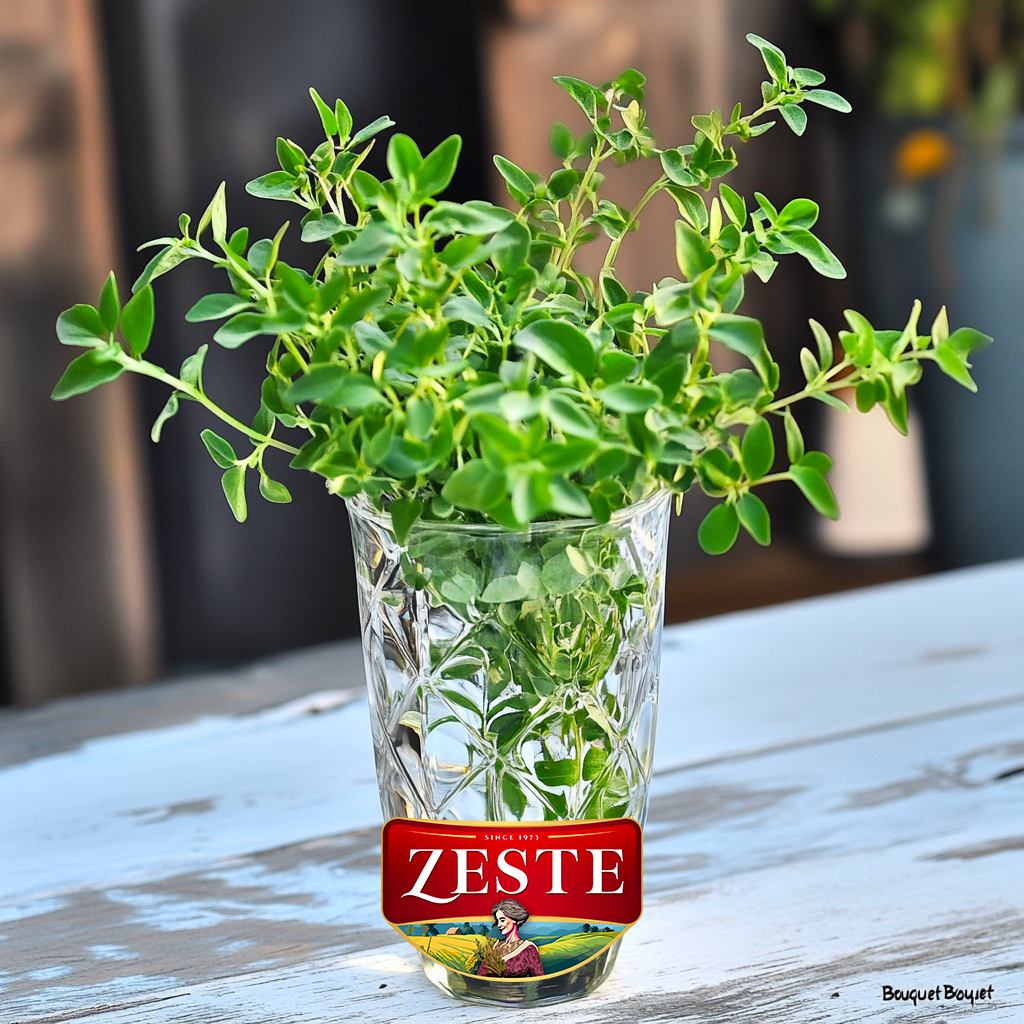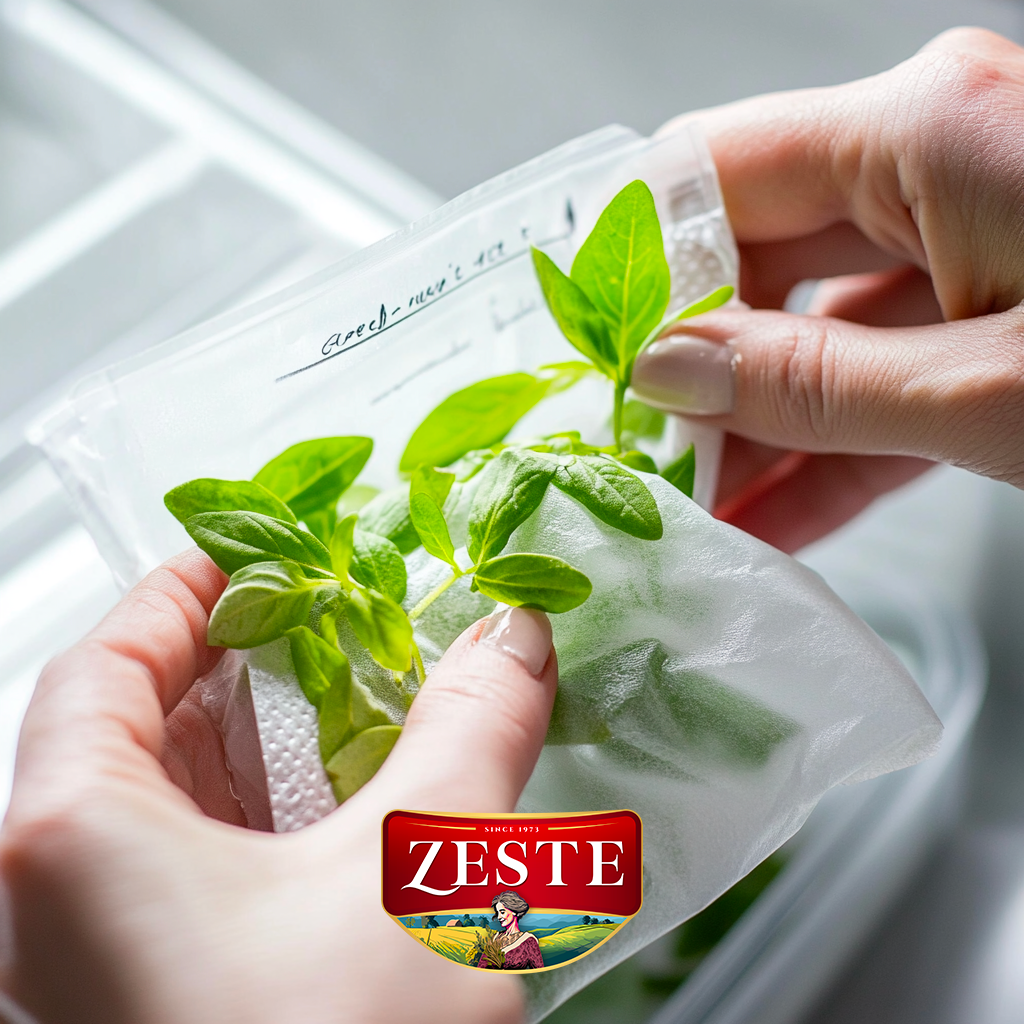How to Store Fresh Oregano?
Storing fresh oregano correctly ensures this aromatic herb is always on hand without losing its punch. Oregano can wither quickly if not stored properly, leaving you with limp, flavorless leaves.
In this guide, we’ll evaluate the best storage methods – refrigeration, freezing, and drying – with clear steps and expert tips for each. By the end, you’ll know exactly how to extend the life of your oregano and maximize its freshness and flavor. Storing Fresh Oregano in the Refrigerator (Short-Term)
Refrigeration is the go-to method for short-term storage of fresh oregano. Refrigerated oregano can stay fresh for several days to a week when stored properly. It will not lose much flavor. Below are two effective ways to refrigerate oregano.
Method 1: Oregano “Bouquet” in Water
If you plan to use your fresh oregano within a day or two, storing the sprigs like a bouquet in water is very effective. This method keeps the herbs hydrated and prevents wilting, much like keeping cut flowers fresh.
- Trim the stems: Cut off the bottom of the oregano stems (especially any woody ends) to create a fresh surface for water uptake. Harvest slightly longer stems if possible.
- Fill a jar with water: Take a clean glass or jar and add about 1–2 inches of water to the bottom. You only need enough to cover the stem ends.
- Place the oregano in the jar: Put the oregano sprigs stem down into the water. Make sure all the cut ends are submerged. The leaves themselves should remain above the water line to avoid rot.
- Cover loosely: Drape a plastic bag loosely over the top of the jar and oregano. This creates a humid “greenhouse” around the herbs while still allowing some air circulation. Ensure the bag doesn’t squish the leaves; it should tent over the oregano.
- Refrigerate and monitor: Place the jar with the covered oregano in the refrigerator. Ideally, keep it toward the front of a shelf or in a cool spot where it won’t get knocked over. Change the water daily to keep it fresh and prevent bacteria growth. Each day, check the water level and the condition of the stems.

Method 2: Damp Paper Towel & Plastic Bag
The damp paper towel method is highly recommended for slightly longer storage in the fridge (up to about a week). This technique provides moisture without waterlogging the herbs, and it protects them in the refrigerator’s crisper. Follow these steps:

- Gently clean (if needed): If your oregano is garden-fresh and has dirt on it, give the sprigs a gentle rinse in cool water. Shake off excess water and pat the herbs completely dry with paper towels. (Any extra moisture can lead to spoilage, so be thorough.) If the oregano is already clean, skip washing to avoid introducing unnecessary moisture.
- Wrap in a damp paper towel: Take a slightly damp paper towel (it should be damp to the touch, not dripping). Wrap it loosely around the oregano sprigs or leaves. The damp towel provides a humid environment that prevents the oregano from drying out, while loose wrapping ensures air can still circulate.
- Place in a plastic bag: Put the paper towel-wrapped oregano into a plastic zip-top bag. Press out most of the excess air from the bag without crushing the leaves, then seal it. Leaving just a tiny bit of air is okay – the goal is to maintain slight humidity without trapping a lot of air or condensation. For the best results, store the bag in your refrigerator’s crisper drawer.
- Label and date (optional): It can be helpful to label the bag with the current date. While fresh oregano likely won’t last long enough to be unrecognizable, dating helps you keep track of how many days it’s been stored.
- Check periodically: Every day or two, take a peek at your oregano. If you notice any leaves turning dark, soft, or moldy, remove those immediately to prevent spoilage from spreading.
How long it lasts: Using this damp paper towel method, fresh oregano can stay fresh for about a week in the refrigerator. The paper towel retains enough moisture to keep the oregano lively, while the plastic bag creates a stable environment. By day 5 to 7, you may notice some loss of vibrancy or aroma, which is a sign to use it up soon.
Expert Tip: Avoid over-wetting the paper towel. It should be barely damp, not wet. Too much water can cause the leaves to become slimy or develop mold. Also, do not seal the bag completely airtight – a little airflow keeps condensation from building up. The balance of slight humidity and air keeps oregano fresh for the longest.
Remember, do not wash the oregano before this storage method; any added water can shorten its life. Instead, wash the herbs right before you plan to use them. By refrigerating your oregano using either the water-in-jar method or the damp paper towel method, you’ll prevent it from withering in the fridge prematurely.
Proper refrigeration can keep oregano fresh for several days (and up to a week) instead of just wilting after 24 hours. Choose the method that fits how soon you’ll need the herb.
Freezing Fresh Oregano (Long-Term Storage)
Freezing is the best option when you have more fresh oregano than you can use in a week, or if you want to preserve its flavor for out-of-season use. Frozen oregano retains much of its aroma and taste, and it can last for many months.
Below are two effective freezing methods: freezing the leaves/sprigs themselves and freezing oregano in ice cubes (with water or oil). Both methods lock in flavor but choose based on how you plan to use the oregano later.
Before freezing, start with clean, dry oregano. Rinse the sprigs gently under cool water if they’re dusty, then pat completely dry. Any water on the leaves can form ice crystals and diminish quality, so let the oregano air-dry for a short while after patting until no surface moisture remains.
Method 1: Freezing Whole Oregano Leaves or Sprigs
Freezing whole leaves (or entire sprigs) is a quick way to preserve oregano with minimal prep. It allows you to measure out whole sprigs or crumble off leaves as needed later. Here’s how to do it:
- Prepare the oregano: Remove any discolored or tough stems. You can freeze oregano on the stem or strip the leaves off – it’s up to you. Freezing on the stem is convenient if you’ll be using sprigs in soups or stews, whereas freezing just the leaves saves space and is handy for crumbling into recipes.
- Pre-freeze on a tray (optional but recommended): Lay the oregano flat on a baking sheet lined with parchment paper in a single layer. Spread out the sprigs or leaves so they aren’t piled up. Place the sheet in the freezer and freeze for a few hours until the oregano is solid. This flash-freezing step keeps the leaves separate and prevents them from clumping together in storage.
- Transfer to a freezer bag or container: Once the oregano is firm, take the sheet out and quickly transfer the frozen sprigs/leaves into a freezer-safe plastic bag or airtight container. Press out as much air as possible from the bag to prevent freezer burn, then seal it tight. If using a container, fill it to the top (to minimize air space) before sealing.
- Label and freeze: Label the bag or container with the date and contents (“oregano”) and return it to the freezer. Try to place it in a spot where it won’t get crushed – you want the leaves to remain intact and not pulverize under heavy items.
How to use: Whenever you need oregano, you can take out just the amount you need. The frozen leaves can be used directly in cooking without thawing – crumble them into your dish or toss a whole sprig into a soup or sauce. They will thaw almost instantly from the heat of cooking, releasing their flavor. This means you don’t have to plan ahead to defrost frozen oregano; it’s ready to go at a moment’s notice.
Shelf life: For the best flavor, use frozen oregano within about 6 months to 1 year. When appropriately stored with minimal air exposure, frozen oregano maintains quality for up to a year. After that, it will still be safe to use, but you might notice the taste and aroma fading. If you’ve frozen the oregano submerged in oil (see below), try to use it within roughly 6 months for optimal flavor.
Method 2: Freezing Oregano in Ice Cubes (Water or Oil)
Another convenient way to freeze oregano is by packing it into ice cubes. This method is fantastic if you want pre-portioned oregano that you can drop straight into soups, sauces, or sautés. You can use plain water or olive oil as the freezing medium. Freezing in oil has the advantage of preserving flavor and texture even better (and the herbed oil can be a nice starter for cooking).
Here are the steps:
- Chop or portion the oregano: Take your clean, dry oregano leaves off the stems (woody stems can be discarded for this method). Chop the leaves roughly with a knife. Alternatively, for a rustic approach, you can leave the leaves whole or just slightly crushed – choose based on how you’ll use them later (chopped is great for directly stirring into foods).
- Load an ice cube tray: Spoon the chopped oregano into the compartments of an ice cube tray. Fill each slot about halfway or up to two-thirds with the herb. Don’t overpack; you want room for water or oil to fill in around the leaves.
- Add liquid: Decide whether you want to use water, broth, or olive oil:
- Water or Broth: Pour in just enough water (or vegetable/chicken broth) to cover the oregano in each compartment. This will freeze into a solid cube with the oregano suspended in it. Water is neutral, but broth can add extra flavor when you use the cube in soups or stews.
- Olive Oil: If you prefer, cover the oregano with olive oil instead. Oil coats the leaves and helps prevent freezer burn, locking in the oregano’s aroma. These herb-oil cubes can be directly tossed into a pan to melt and sauté as a flavor base.
- Freeze the cubes: Place the ice cube tray flat in the freezer and let it freeze until solid (usually overnight or about 8 hours to be safe).
- Transfer to storage: Once the oregano cubes are fully frozen, pop them out of the tray. Work quickly to prevent them from melting. Transfer the cubes into a freezer bag or airtight container. Again, remove as much air as possible from the bag before sealing. Keep the cubes in the freezer until needed. Label the bag with the date and contents (especially if you made both water and oil cubes, label which is which).
How to use: Grab an oregano cube whenever you need one. You can drop frozen oregano cubes directly into your cooking. If it’s a soup or sauce, the cube will melt and release the herbs as it simmers. If using an oil cube, you can melt it in a skillet as the start of a sauté or sauce. There’s no need to thaw the cubes in advance.
Shelf life: Just like freezing whole oregano, try to use oregano ice cubes within about 6-12 months. The olive oil cubes are best used within about 6 months (oil can degrade slightly over long freezer storage), while water-based cubes can last closer to a year with good flavor. Always keep an eye on the color and aroma of your frozen oregano – if it starts to look dull or ice-crusted, it may be past its prime.
Expert Tip: For maximum flavor retention when freezing: work with completely dry herbs and freeze as soon as possible after harvesting or buying. The quicker oregano goes into the freezer at peak freshness, the more flavor it will retain. Also, using olive oil to freeze can preserve the oregano’s essential oils better than water alone, giving you a more vibrant herb when thawed.
Finally, make sure to exclude as much air as you can from containers to prevent freezer burn on the delicate leaves. By freezing fresh oregano, you can enjoy its bold taste long after the growing season. Whether you freeze the leaves on their own or in handy ice cubes, you’ll always have a supply ready to sprinkle into your favorite dishes.
Conclusion
With these methods, you now know how to store fresh oregano like a pro, whether you need to keep it fresh for a few days in the fridge or preserve it for months by freezing or drying. By following the step-by-step instructions and tips above, you’ll ensure your oregano stays green and flavor-packed instead of ending up wilted or bland.
Now it’s time to put your preserved oregano to good use! Try sprinkling your refrigerated oregano on a homemade pizza, dropping a frozen oregano cube into a soup, or using your freshly dried oregano in a pasta sauce – you’ll taste the difference that proper storage makes.
Ready to learn more? If you enjoyed these oregano storage tips, be sure to check out our other herb guides. You might love our article on using oregano in your cooking and our guide to growing your own oregano for an endless supply (internal links). With the right techniques, you can enjoy home-grown flavor year-round.
Explore more of our oregano content and keep cooking with confidence!
